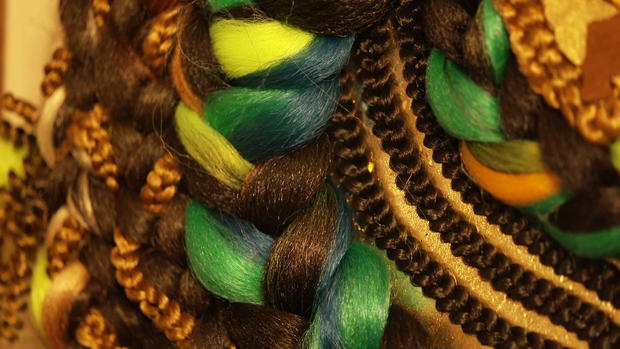The 19th century Lyndhurst Mansion, a riverside home-turned-museum in Tarrytown, New York, is a place that conjures images of a time gone by – a surprising venue for an art exhibit that includes antique quilts and a beaded toilet.
Howard Zar, executive director of Lyndhurst Mansion, is co-curator of a new exhibit that’s full of surprises, called “Women’s Work,” a presentation spanning 300 years featuring historic and forgotten works, many crafted by anonymous women. He told correspondent Faith Salie, “Women’s work that is performed in the home in a domestic setting, like the one that we’re in, although a grand one for that matter, all that gets diminished and marginalized.”
Zar’s goal was to present historic pieces made by women side-by-side with those of well-known contemporary female artists who still struggle to be seen.
“What struck me oftentimes is how frequently women were adopting these handcrafts into their work,” he said. “It may not have been the central point of how they worked, but it was always there.”
Bruce M. White
He’s taking about artists like Faith Ringgold with her dolls and story quilts; Judy Chicago and her famed dinner plates; and Liza Lou and her beaded toilet complete with a roll of beaded toilet paper – all inspired by the works of women who came before them.
Zar said, “I wanted to recognize that these women artists created a revolution. They changed the way we look at things. And ultimately this work is wonderful; it’s lovely and it’s joyous work.”
Like this sculpture by contemporary artist Kathleen Ryan, whose piece include a rotting lemon. “The story of the lemon is that the artist was influenced by the beaded fruits that women made from kits in the 1940s and the 1950s; she collects those.”
When the show came together, Zar was struck by something unexpected: “We thought it would be the contemporary artists that we were uplifting. But in many ways, we’ve uplifted the historic artists who are often looked at as anonymous, small, little housewives doing unimportant things. It actually elevated the women from the past.”
Among the contributions by women of the past are needle-pointed cushions made by Martha Washington, known to be an excellent seamstress. Another interesting piece of stitchwork: a pair of 19th century bloomers, embroidered by contemporary artist Zoe Buckman. “She takes specific rap lyrics that are referring to potentially objectification of women,” Zar said.
An example of women taking their representation into their own hands.
Bruce M. White
Zar showed two examples of African American representation through a pair of dolls: an early 20th century rag doll by an anonymous artist dressed in cap and apron (“The outfit that’s she’s wearing is an outfit that was worn by servants both Black and white at the time; this is not a stereotypical representation, it’s an actual representation”); and Faith Ringgold’s 1976 doll depicting an elegantly-dressed African American woman (“the types of people that she saw around her in her Harlem neighborhood that were not being recognized, and were not being seen by the larger Caucasian community”).
CBS News
So, is it craft, or is it art? According to Zar, “You had to study. You had to learn the technique. You had to master the technique. You had to make it better and more beautiful than other people were. So, how is that not art?”
Web exclusive video: Faith Salie talks with artist Valerie Hammond:
Artist Nafis White found inspiration directly from the women who came before her, using industrial items and beauty products. Her piece is made of synthetic hair and bobby pins. “Each time I place a bobby pin to hold something – to hold a braid, to hold a curl – it’s an homage to my grandmothers and how they pinned their hair up,” she said.
Reminiscent of 18th- and 19th-century memorial wreaths made of human hair.
CBS News
“What do you think these women, even girls, would say to see their works being exhibited with such surprising modern feminist works?” asked Salie.
“Finally! Finally you’re seeing what we did and who we were and who women are,” Zar replied.
“They persisted?”
“They persisted! They definitely did.”
For more info:
Story produced by Amy Wall. Editor: Emanuele Secci.



